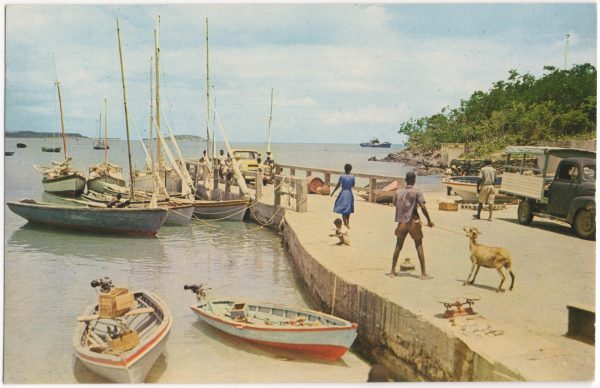
While scanning selections from Barbara Cannegieter’s enormous collection of postcards, it was interesting to see how they changed through the years. Postcards are made to represent a place, or the ideal of a place. But places change, especially St. Martin.
Very early postcards, from the late 19th and early 20th centuries mostly document “important” things. Marigot and Philipsburg are there because they are the capitals. Front Street is featured because it is Front Street. St. Martin was a faraway place back then, more remote than anyone today could probably imagine. A postcard may have been a way of proving that it existed at all.
Over time, postcard images became more diverse. Many highlighted the natural beauty of green hills and unspoiled beaches. Scenes of Caribbean life were also popular: fishermen with their catch and produce for sale at Marigot market. The unique architecture of the island along Rue de la République and other streets is often on display.
Eventually, St. Martin as a tourist destination became the subject of many postcards. Hotels and resorts were on postcards, from the extravagant fake Mediterranean village of La Belle Creole to a variety of boxy and inelegant hotel buildings. Tourists appear in postcards, doing duty free shopping and water sports.

Postcards reflect different views of the island. They were made to appeal to buyers, so they reflect what those buyers loved about St. Martin. At least, the ones that sold. They also helped create the image of St. Martin. These very specific images were how St. Martin was shared around the world.
How we see these images today can also tell us a lot. For St. Martiners, and others who love the island, postcards are powerful. Familiar views of towns bring a rush of nostalgia. People recognize the faces of fishermen and shopkeepers. Images of unspoiled landscapes often bring a sense of loss.
The St. Martin of all these old postcards is gone. Or at least, it has changed to the St. Martin of today. Simpson Bay will never be unbuilt, but we could protect the last few wild views. Some of the classic Caribbean houses of Grand Case, Marigot and French Quarter may be crumbling, but many could still be returned to glory. St. Martin may not have any fishing villages today, but it still has people who fish.

In every postcard, there is an element of St. Martin that is still here, whether it is a place, a tradition or a feeling. Perhaps it is hidden, perhaps it is in disrepair, perhaps it is hanging by a thread. But it is not too late to save a little bit of what we love from the past.
What do you miss from St. Martin’s past? What needs to be saved today? Tell us about it by writing in to The Daily Herald or to info@lesfruitsdemer.com.
See more old postcards and photos at the St. Martin Image Collection.

